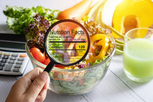Have you ever felt that you couldn’t make sense of all the data shown on food labels? You have company! But there’s no need to worry anymore; it is actually quite possible to read these labels. Let’s find out how to make smart decisions when we shop for groceries.
1. Serving Size: A Crucial Concept for Quantity Understanding
The label’s key feature is the serving size. It’s a starting point for the nutritional data that follows. You may end up eating the entire bag in one sitting, so keep that in mind when you’re planning your portion sizes. When shopping for enticing goodies, be sure to check the portion size per container.
2. Revealing the Nutritional Value: Allies and Enemies
 Numerous nutrients, some of which are good for you and others of which you should limit your intake of, are displayed on the label. In a nutshell, here it is:
Numerous nutrients, some of which are good for you and others of which you should limit your intake of, are displayed on the label. In a nutshell, here it is:
Make Time for Friends
Essential for good health, seek out foods high in fiber, vitamins, and minerals.
Reduce the Enemies
Be wary of added sugars, salt, saturated and trans fats.
3. % DV (Daily Value): Your Unique Measurement Standard
One serving provides the recommended daily value (RDV) for a certain nutrient. As a general guideline: Good source of that vitamin if it’s 20% DV or above. At or below 5% DV, the nutrient is considered poor.
Conclusion
If you know the serving sizes, important nutrients, and %DV of the foods you buy, you can make better choices. Keep in mind that food labels are there to help you; make informed decisions when you shop!
